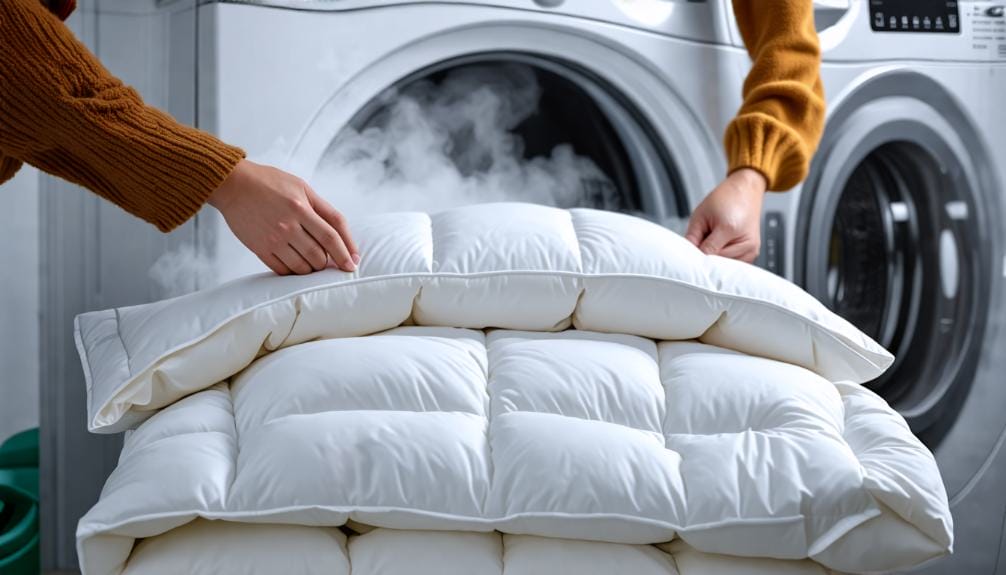How to Wash a Real Down Comforter? Step-by-Step Guide
When it pertains to washing a real down comforter, you might be unsure where to start. First, you’ll want to check the care label for specific guidelines, as different comforters have unique needs. After that, inspecting for stains and tears is essential before you even think about tossing it in the wash. But what comes next? Comprehending the washing process and choosing the right detergent can make all the difference in preserving your comforter’s quality. Let’s explore the step-by-step method to guarantee your comforter stays fluffy and fresh.
How to Wash a Real Down Comforter?

Washing a real down comforter requires careful attention to preserve its quality and longevity.
First, check the care label for specific washing instructions, as following these guidelines is crucial for effective cleaning. Prepare your washing machine with lukewarm water and a gentle, mild detergent specifically formulated for down products. Using harsh chemicals can harm the feathers and the fabric, leading to deterioration.
Load the comforter into the washing machine, ensuring there’s enough space for it to move freely. This is essential for thorough cleaning and helps maintain the comforter’s shape. Select a gentle cycle to minimize agitation, which helps keep the down fluffy and the fabric intact.
After the washing cycle, transfer the comforter to the dryer. Use a low heat setting to prevent overheating, which can damage the down filling. Adding dryer balls is a smart move; they help distribute the down evenly and prevent it from clumping, promoting a fluffy finish.
Throughout the washing and drying process, regularly check the comforter. Inspect it carefully to make sure it’s clean and free from damage.
What Detergent for Down Comforters?
Using the right detergent for your down comforter is crucial for preserving its quality and performance. Regular laundry detergents often contain harsh chemicals that can strip away the natural oils in down, resulting in reduced loft and warmth.
To keep your comforter in top shape, consider these practical tips:
- Gentle Formulation: Choose a detergent that’s specifically designed to be gentle on delicate down materials. This helps maintain the fluffiness and insulation properties of the comforter.
- Specialized Products: Look for brands that offer detergents tailored for cleaning down items. These products are formulated to clean effectively without damaging the down.
- Odor Control: Some detergents are formulated with odor-neutralizing properties, which can help keep your comforter smelling fresh after washes.
Can You Dry Clean a Down Comforter?

Dry cleaning a down comforter may seem like an easy option, but it can actually compromise the comforter’s natural properties. The solvents used in dry cleaning often strip away the down’s natural oils, which can lead to reduced loft and warmth. If dry cleaning is necessary, it’s crucial to find a cleaner that specializes in down and employs gentle techniques.
Washing your comforter at home is typically more effective than dry cleaning. By using a mild detergent specifically designed for down, you can preserve the integrity of the feathers while effectively cleaning the fabric. Home washing also allows you to tackle any specific stains or odors directly, ensuring a thorough clean.
Cost is another factor to consider. Dry cleaning can be significantly more expensive than washing your comforter at home. For heavily soiled comforters or those with persistent odors, opting for a gentle wash cycle and proper drying methods is usually the best route. Your down comforter deserves quality care, and washing it yourself often keeps it fluffy and cozy for many years.
Step-by-Step Washing Process
To wash your down comforter effectively, prepare it first to make sure it’s ready for cleaning.
Choose the right washing cycle and use a suitable detergent that protects the down.
Pay close attention to the washing temperature; it’s crucial for keeping the comforter’s quality intact.
Preparing the Comforter
Before you wash your comforter, it’s crucial to inspect it for stains and any damaged areas. This step ensures your comforter receives the proper care it requires.
To tackle stains, gently blot them with a clean cloth. If you find any significant damage, consider taking it to a dry cleaner for professional help.
Here’s how to prepare your comforter for washing:
- Look for any visible stains and treat them with a stain remover or a homemade solution to prevent them from setting in during the wash.
- Examine the seams and fabric for tears or weak spots, as these may need repair before washing to avoid further damage.
- Make sure your washing machine has enough water capacity to accommodate the comforter without cramming it in, which can lead to ineffective cleaning.
Choosing the Right Cycle
Choosing the appropriate washing cycle for your down comforter is crucial for its care and longevity. A gentle cycle on your washing machine is recommended because it reduces agitation, protecting the delicate fabric from damage. This gentle approach helps maintain the fluffiness of the down feathers, which can suffer if subjected to harsh washing conditions.
Before washing, verify that your comforter fits well in the machine. Overcrowding prevents proper cleaning and can lead to uneven wear. A gentle cycle mimics hand-washing, allowing the down to move freely and ensuring thorough cleaning. Use lukewarm water, as this temperature helps avoid shrinkage and protects the down from harm.
While focusing on the wash cycle is important, the type of detergent you use is equally vital. Opt for a mild detergent designed for down or delicate fabrics to preserve the natural oils in the material.
This careful consideration of both the washing cycle and detergent will keep your comforter fluffy and extend its life, ensuring it provides warmth and comfort for many years.
Adding Detergent
Set your washing machine to a gentle cycle and fill it with lukewarm water.
Adding the right detergent is crucial for cleaning your down comforter while protecting its delicate feathers.
For effective cleaning, consider the following options:
- Mild laundry detergent: Choose a gentle formula to preserve the natural oils in the down.
- Down-specific detergents: These are specially formulated for washing down items and are highly recommended.
- Natural alternatives: Vinegar can be used alongside detergent to help eliminate odors effectively.
Pour the recommended amount of your chosen detergent into the machine, ensuring it dissolves well in the water.
Lukewarm water helps activate the detergent without harming the down.
This careful approach will leave your comforter clean and fluffy, ready to provide warmth during those cold nights.
Washing Temperature
Washing your down comforter at the right temperature is crucial for keeping it in top shape. Always opt for lukewarm water, as extreme temperatures can harm the delicate down filling. Hot water may cause feathers to shrink, while cold water often struggles to remove dirt and oils effectively.
Set your washing machine to a gentle or delicate cycle. This setting minimizes agitation, which protects both the fabric and the down from unnecessary wear and tear. Remember, your comforter is more than just a blanket; it’s a key component of your comfort.
Before washing, check your detergent. Use a mild or specialized down detergent, as harsh chemicals can strip the natural oils from the feathers. Adding a small amount of vinegar can also help with cleaning and odor removal.
After washing, drying is just as important. Use dryer balls on a low heat setting to keep the down fluffy and prevent clumping. This careful approach ensures that your comforter retains its loft and warmth, allowing you to enjoy its cozy embrace for years to come.
Drying Your Down Comforter

To dry your down comforter, use dryer balls to keep the down fluffy and prevent clumping.
Set your dryer to low heat to protect the feathers and make sure the comforter dries completely.
Periodically fluff the comforter during the drying process for the best results.
Using Dryer Balls
Using dryer balls in your dryer is essential for keeping your down comforter fluffy and evenly dried. These simple tools help prevent the down from clumping together, allowing for better air circulation and moisture removal.
Here are some practical benefits of using dryer balls:
- Fluffiness: Dryer balls effectively separate the down, promoting loft and allowing air to circulate freely.
- Shorter Drying Time: By absorbing moisture, dryer balls can significantly reduce the time it takes to dry your comforter.
- Natural Softening: Unlike liquid fabric softeners, dryer balls provide a chemical-free method to soften your comforter.
To maximize these benefits, add a few dryer balls to the dryer with your down comforter. This will help keep the comforter’s shape and warmth intact.
Use a low heat setting to protect the delicate fibers of the down. Check on your comforter periodically and give it a shake if necessary to ensure even drying.
Following these steps will help you maintain the quality and comfort of your down comforter for years to come.
Low Heat Settings
Dry your down comforter on a low heat setting to avoid overheating and to keep its fluffy texture intact. High temperatures can harm the down filling, causing it to clump and lose its loft.
Before putting your comforter in the dryer, choose the low heat option. This method allows for effective drying while being gentle on the delicate feathers inside.
As the comforter dries, check it periodically to ensure even drying. If you notice damp spots, redistribute the comforter in the dryer.
Adding dryer balls can also help maintain fluffiness by preventing the down from clumping together, ensuring that it dries evenly and retains its light, airy feel.
Fluffing Techniques
To keep your down comforter fluffy and avoid clumping, effective fluffing techniques during the drying process are essential. Here’s how to achieve a fresh, lofty comforter:
- Use dryer balls: Adding dryer balls to your dryer prevents down clusters from sticking together. This promotes even drying and helps maintain fluffiness.
- Set to low heat: Dry your comforter on a low heat setting. This protects the down feathers from overheating, which can cause damage and reduce loft.
- Check periodically: Every 30 minutes, take a moment to check on your comforter. This allows you to redistribute the down, ensuring it dries evenly and maintains its shape.
Maintenance Tips for Down Comforters
To keep your down comforter in great condition, follow these maintenance tips.
Spot clean any stains immediately, and regularly check for signs of wear and tear.
When it’s time to store your comforter, do so correctly to avoid any damage and to keep it fresh for your next cozy night.
Spot Cleaning Stains
Spot cleaning stains on your down comforter is crucial for keeping it looking fresh and extending its lifespan. Stains can quickly set in, so it’s best to act quickly. Follow these practical steps for effective spot treatment:
Collect your materials:
Grab a clean cloth, a gentle detergent, and a soft brush or toothbrush.
Blot the stain:
Take the clean cloth and gently blot the stained area to soak up any excess liquid. Avoid rubbing, as this can push the stain deeper.
Prepare the detergent solution:
Mix a small amount of gentle detergent with water. Dampen your cloth with this solution and apply it to the stain. Use the soft brush to gently work the detergent into the fabric.
Rinse and dry:
After treating the stain, use another clean cloth dampened with plain water to remove any soap residue. Allow the area to air dry completely before using the comforter again.
Regular Inspections
Regular inspections of your down comforter are essential to identify potential problems early, keeping it warm and comfortable for longer. By routinely checking for stains, wear, or damage, you can address issues before they worsen, which ultimately extends the life of your comforter.
Here’s a straightforward checklist to guide your inspections:
| Inspection Area | What to Look For | Action to Take |
|---|---|---|
| Surface | Stains and dirt | Apply spot treatment using a soft brush |
| Seams | Fraying or loose threads | Sew or reinforce as necessary |
| Loftiness | Clumping or flattened areas | Shake and fluff the comforter |
For any stains, a gentle spot treatment can be very effective. Use a soft brush or a clean cloth to prevent any damage to the fabric. By regularly inspecting your comforter, you ensure it remains a reliable source of warmth and comfort for years ahead. A little routine care now can save you from bigger problems down the line!
Storing Comforters Properly
Proper storage of your down comforter is essential to keep it fluffy, warm, and in excellent condition during off-seasons. Here’s how to do it effectively:
- Choose a breathable storage bag: This allows air to circulate while keeping out dust, which helps prevent damage.
- Add a waterproof layer: Using a bag with a waterproof feature protects your comforter from moisture, which can lead to mold and mildew.
- Include a dry towel: Adding a dry towel helps absorb any excess moisture that may develop, further protecting your comforter.
Before you tuck your comforter away, make sure it’s completely dry. Any remaining moisture can cause unpleasant odors and mold growth.
By following these practical steps, you can significantly increase the lifespan of your down comforter, ensuring it stays cozy and welcoming for many seasons to come.
Proper storage is just as vital as washing, so take the time to do it correctly!
Frequently Asked Questions
How Often Should I Wash My Down Comforter?
You should wash your down comforter every six months to a year, depending on usage. If you notice stains or odors, it’s a good idea to clean it sooner. Regular maintenance keeps it fresh and inviting.
Can I Use Fabric Softener on a Down Comforter?
You shouldn’t use fabric softener on a down comforter. It can coat the down feathers, reducing their loft and insulation properties. Stick with gentle detergents to keep your comforter fluffy and warm for years.
What Should I Do if My Comforter Smells?
If your comforter smells, try airing it outside on a sunny day. If that doesn’t work, wash it using a mild detergent and add vinegar to help eliminate odors, ensuring it dries thoroughly afterward.
Is It Safe to Wash a Comforter With a Duvet Cover?
Yes, it’s safe to wash a comforter with a duvet cover. Just make sure both items fit in your machine, use a gentle cycle, and select an appropriate detergent to keep everything fresh and clean.
Can I Hand Wash My Down Comforter Instead?
Yes, you can hand wash your down comforter! Just use lukewarm water and a gentle detergent. Carefully submerge it, agitate softly, then rinse thoroughly. Remember to dry it completely to maintain its fluffiness.
In Conclusion
Washing your down comforter doesn’t have to be intimidating. By following the care label instructions and using the right detergent, you can keep it clean and fluffy.
Remember to treat stains beforehand and dry it properly to maintain its loft. With these steps, your comforter will stay fresh and cozy for years to come.
Regular maintenance will also help extend its life, ensuring you enjoy snuggling up under it every night.
Happy washing!
